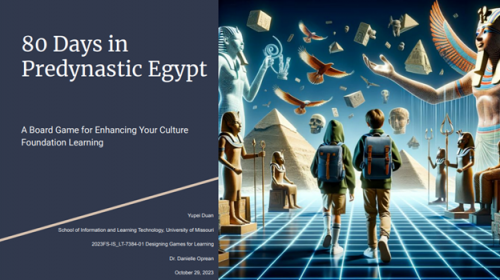Level 3 – Iteration Equals to Rebirth
“What you get by achieving your goals is not as important as what you become by achieving your goals.”
– Zig Ziglar

Iteration and rebirth can be seen as similar in the sense that they both involve a process of renewal and transformation. During the ongoing progress of the course “Designing Games for Learning”, I felt that not only did my games undergo multiple iterations, but my mind also experienced numerous rebirths throughout the same process.
On level 3, I used the games from Level 1 I played as mentor games to design my board game. All the competencies I relied on were from previous practices, readings, discussions, and assignments. I could see my board game more and more clearly approaching to the submission deadline. I hoped to make it better, but the time was always limited. So, I will just record the current status of my board game 80 Days in Predynastic Egypt here in my blog, and waiting for the next round iteration for the game.
Analog Game Design & Prototype Video (7384)
- Game Title:80 Days in Predynastic Egypt
- Video Introduction: https://www.youtube.com/watch?v=_GEB_nXqdNA
- Subject area: History & Geography
- Learning domain, learning goal/objective: The architectures, religious system, and civilization development in Ancient Egypt
- Who are the players: Students in Grade 4- Grade 8 who have recently learned about Predynastic Egypt. The student players will form groups, each group consisting of 3 to 4 students.
- Premise of the game: Hi students, many of you are familiar with Magic School Bus, which is the title of a series of fictional scientific books. In this game, 80 Days in Predynastic Egypt, a board game will give you a chance to get on the magic school bus to have a virtual venture in Ancient Egypt, and I will be your driver. During the game, you will use your learnt knowledge about ancient Egypt to embark on your group adventure, you and your group members will be invited to share your journey after the game. Are you ready?!
- Game Goal. To resolve the problems related to Egyptian civilization in 80 turns and create a team story to introduce Predynastic Egypt based on the questions and learning from the culture foundation course.
- Learning Objectives.
Learning objective 1: To use the knowledge learnt from the Culture Foundation course to resolve the problems in the game.
Learning objective 2: To create a group-made Predynastic Egypt journey report for all players.
- Content.

A game board contains 80 grids on behalf of 80 turns(days) in the game.

There are three different icons on the board on behalf of different challenges: Civilization Development Challenges, Religious System Challenges, and Architecture Challenges.

The reward cards and penalty cards will bring random affairs related to Ancient Egypt to increase or decrease the players time travel opportunities. When the players have more chances to do the time travel, they can have more opportunities to explore in Ancient Egypt to discovery more knowledge with holding the reward cards. And the penalty cards will shorten the players time travel journey, then the players will have less chance to find more details for their final group presentation.
- Setup. Before the game begins, the student players will form groups, each consisting of 3 to 4 students. During the game, each group of students will represent a group of tourists, and they will roll the dice to determine their pace in the virtual journey through Predynastic Egypt. The game board features illustrations on the grids that depict challenges, bonuses, or penalties, all of which are related to the real history, civilization, and religion systems of ancient Egypt. Some grids will lead the players to check the “Reward” or “Penalty” cards to add more story details, random and fun.
- How to Play. In a turn, the player will roll the dice, then move the Player chess to the relative grid according to the number on the dice, then the player will check the information on the grid. Different grids contain different information, like: penalty, reward, common step, which will lead the player to check relative cards or information to compose a journey story (Core loop). Each round of the game will be finished in 80 turns. Then, all the players will collaborate to solve problems and use their game experience to create a presentation that introduces their virtual journey, helping them learn and review knowledge about predynastic Egypt.
- End of Game. The game will be over when all the players share their stories after finishing all the grids on the boards. The teacher will lead the students to reflect all the learnings they covered in the Ancient Egypt module in the culture foundation course.
- Statement about Learning.
Game Elements Embedded in 80 Days in Predynastic Egypt
Goals: The simple introduction of a goal adds purpose, focus, and measurable outcomes (Kapp, 2012, p. 68). In my game, the instructors from the Culture Foundation class will illustrate the game goals which are helping students eager to explore using their learnt knowledge. This game is another way to assist students to retrieve. The fact that retrieval practice, spacing, rehearsal, and the construction of mental models improve learning and memory is evidence of neuroplasticity and is consistent with scientists’ understanding of memory consolidation as an agent for increasing and strengthening the neural pathways by which one is later able to retrieve and apply learning (Brown et al., 2014, p. 172).
Conflict, Competition, or Cooperation: While it is helpful to consider the elements of conflict, competition,and cooperation separately, often good game design includes elements of all three (Kapp, 2012, p. 73). The student player will cooperate with the group member to develop their virtual journey stories. They need to resolve the conflicts together when they encounter some challenges while playing. During the showcase session, friendly competition will happen between different groups, while the student player will learn other teams’ stories to enhance their own to improve their learning.
Feedback: during the showcase session, the audience including the students and teachers will provide feedback to the storytellers as feedback to improve their understanding about Ancient Egypt.
Storytelling: storytelling plays a very important role in the serious game. All the students need to consider how to compose their adventure story while playing the game. As an educator, if I just ask my students to engage in mechanical repetition, they quickly hit the limit of what they can keep in mind. However, if they practice elaboration, there’s no known limit to how much they can learn. Elaboration is the process of giving new material meaning by expressing it in their own words and connecting it with what they already know. The more the students can explain about the way their new learning relates to their prior knowledge, the stronger their grasp of the new learning will be, and the more connections they create that will help them remember it later (Brown et al., 2014, p. 5).
The elements of “ALLUE of Play” in 80 Days in Predynastic Egypt
There are a lot of strategies and resources for designing an educational board game in the book The Educator’s Guide To Designing Games and Creative Active-Learning Exercises – The Allure of Play. I considered some simple mechanics or complex mechanic activities introduced in the book to design my game.
Simple mechanics(Bisz et al., 2023)
- Random: The dice, the reward and penalty cards will bring randoms to the players.
- Role: Students will play the roles as time travelers in Ancient Egypt.
- Rival: Students tend to compose their stories to be more vivid, literatical, and informatic to compete with other teams.
Complex mechanic activities(Bisz et al., 2023)
- Trivial Questions: understand through recall and review. Many grids on the board will be linked with questions related to Ancient Egypt knowledge. The students will answer the question to continue the game, while preparing their group story report.
- Brainstorming & Creation: Create a quick list for later appraisal. The student players will form a group to brainstorm their final story presentation.
- Simulation Role-play: Create by identifying with other perspectives. Since some challenges the students encounter will bring the students to a historical context, to let the students play a role and make some decision to continue the game.
- Statement about your Mentor Games.
There are a lot of valuable elements I borrowed from my mentor games 1&2. I didn’t only combined my two mentor games’ names surficial, but deeply merry their main mechanics together. The players can find a lot of similar mechanics in the new board game from Predynastic Egypt and 80 Days, e.g. budget plan (resource management mechanics); route selection (control mechanics); dialogues (progression mechanics); turning setting (control mechanics); random affairs (uncertainty mechanics); real historical affairs (progression mechanics).
- Credits. This board game is similar to Monopoly (“Monopoly (Game),” 2023) but it follows a single direction along the chronological development of Ancient Egypt in each round. The target audience is students in grades 4 to 8 who have recently learned about Predynastic Egypt, and can use this board game for review. In my game, 80 days in Predynastic Egypt, the “Chance” and “Community Chest” cards from the original Monopoly will be replaced with “Reward” and “Penalty” cards.
References:
Appendix:
Knowledge about Ancient Egypt on the challenge, reward, and penalty cards (Created by ChatGPT, revised by Yupei Duan).
1. Architectures:
Pyramids: The most iconic structures of ancient Egypt. The Great Pyramid of Giza, built for Pharaoh Khufu, is one of the Seven Wonders of the Ancient World and showcases the precision and architectural prowess of ancient Egyptian builders.
Temples: These were centers for worship and ceremonies. Famous temples include the Temple of Luxor, Karnak Temple, and the Temple of Horus at Edfu. These structures had massive columns, intricate carvings, and were often aligned with celestial events.
Tombs: The Valley of the Kings and Valley of the Queens are famous for their underground tombs, including that of Tutankhamun. These tombs were elaborately decorated with frescoes that narrated the life of the deceased and prayers for the afterlife.
2. Religious System:
Polytheism: Ancient Egyptians practiced polytheism, with a pantheon of gods and goddesses. Each deity had specific roles, and their importance could change over time.
Afterlife: The belief in the afterlife was strong. This is evident in the mummification process, where the body was preserved for the soul’s journey in the afterlife. The Book of the Dead provided spells and instructions for this journey.
Priesthood: Priests played a significant role in society. They conducted rituals, maintained temples, and were intermediaries between the people and the gods.
3. Civilization Development:
Ancient Egyptian civilization can be divided into several periods:
Predynastic Period (c. 6000-3150 BCE): Settlements began along the Nile, with farming communities flourishing due to the fertile land.
Early Dynastic Period (c. 3150-2613 BCE): This saw the unification of Upper and Lower Egypt under Pharaoh Narmer. The concept of a centralized state began to form.
Old Kingdom (c. 2613-2181 BCE): This period is known for the construction of the pyramids. There was a strong centralized government, and the pharaoh was seen as a divine ruler.
Middle Kingdom (c. 2050-1710 BCE): After a phase of decentralization, the Middle Kingdom saw a reunification and a resurgence in art, literature, and building projects.
New Kingdom (c. 1550-1070 BCE): This was the golden age of ancient Egypt, with powerful pharaohs like Ramses II and Amenhotep III. The empire expanded, and there was significant architectural and cultural development.
Late Period (c. 1070-332 BCE): This period saw invasions by foreign powers, including the Nubians, Assyrians, and Persians. Nevertheless, Egyptian culture persisted.
Ptolemaic Period (c. 332-30 BCE): This began after Alexander the Great’s conquest and lasted until the Roman conquest. It saw a fusion of Greek and Egyptian cultures.
